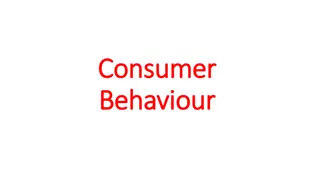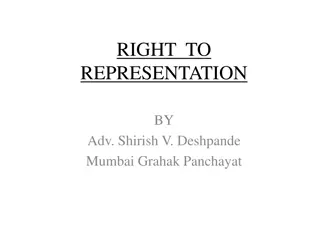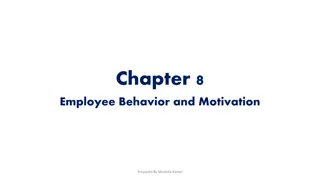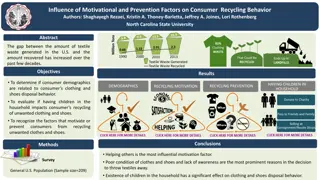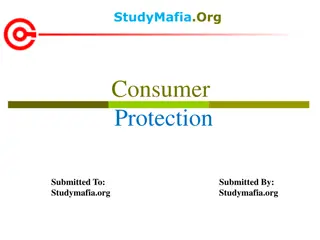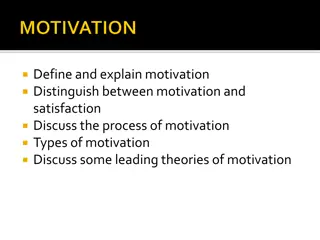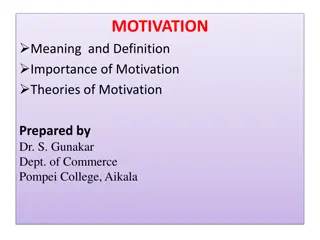Understanding Consumer Motivation and Needs in Buying Behavior
Researchers have identified key psychological factors like motivation, perception, learning, beliefs, and attitudes that influence consumer behavior. Motivation, driven by unfulfilled needs, leads to buying decisions. Motivation levels vary based on need intensity, importance of purchase, and fulfillment rewards. Needs can be basic (physiological) or acquired (learned). Consumers also have utilitarian and hedonic needs, focusing on practical benefits or pleasure respectively. Understanding these factors is crucial for marketers to influence consumer behavior effectively.
Download Presentation

Please find below an Image/Link to download the presentation.
The content on the website is provided AS IS for your information and personal use only. It may not be sold, licensed, or shared on other websites without obtaining consent from the author. Download presentation by click this link. If you encounter any issues during the download, it is possible that the publisher has removed the file from their server.
E N D
Presentation Transcript
Unit III IMBA 6 Sem
Consumer Motivation Scholars and researchers have identified four major psychological factors motivation, perception, learning, beliefs and attitudes that influence consumers' buying behaviour. Motivation is said to be the driving force within us. It is produced by a state of tension caused by our unfulfilled needs and wants. We strive to reduce this tension through appropriate behaviour that we expect will satisfy our needs.
Level of Motivation The level of motivation would depend on the intensity of our need. Our motivational levels may vary from low to high depending on how important is that purchase. Influences include familiarity with the purchase, status factors and overall expense and value. Where fulfillment rewards are low, as with routine purchases like salt, sugar, tea, shampoo etc., motivation levels are also relatively low and involve little decision-making behavior. On the other hand, with a complex, risky and emotionally-charged process such as buying a new car, the drive to achieve the best result is high.
Types and System of Needs 'Needs' can be defined as a felt state of deprivation of some basic satisfaction. The point is that this deprivation has to be felt to drive the individual to seek satisfaction. Every person has needs. Some of these needs are basic to sustaining life and are born with individuals. These basic needs are also called physiological needs or biogenic needs and include the needs for air, water, food, shelter, sleep, clothing, and sex. Physiological needs are primary needs or motives because they are essential to survival.
Needs Acquired needs are learnt needs that we acquire as a result of being brought up in a culture and society. For example, needs for self-esteem, prestige, affection, power and achievement are all considered as learned needs. Acquired needs are generally psychological, resulting from an individual's subjective psychological make up and relationship with others and are considered as secondary needs or motives.
Needs Needs may also be classified even more basically - utilitarian or hedonic. A consumer's utilitarian needs focus on some practical benefits and are identified with product attributes that define product performance such as economy or durability etc. Hedonic needs relate to achieving pleasure from the consumption of a product or service and are often associated with emotions or fantasies. Hedonic needs are more experiential as they are closely identified with the consumption process. For example, a hedonic need might be the desire to be attractive to the opposite sex. The evaluative criteria for brands are usually emotional rather than rational (utilitarian).
Goals Goals can be defined as the solutions that satisfy a specific need. For example, to satisfy hunger any type of food is good enough but the individual consumer's goal may be a chicken roast. Human behaviour is goal-oriented. Marketers are particularly interested in consumers goal-oriented behaviour that concerns product, service or brand choice. They want consumers to view their products or brands as those that would best satisfy their needs and wants. The goal selection depends on an individual's personal experiences, physical capacity and prevailing cultural norms and values and whether the goal object is accessible. Needs and goals are interdependent and neither can exist without the other.
Task Give examples of the products and services that cater to our: biogenic needs, acquired needs and hedonic needs.
System of Needs The hierarchy of needs proposed by Abraham H Maslow is perhaps the best known. Maslow classified needs into five groupings, ranking in order of importance from low-level (biogenic) needs to higher-level (psychogenic) needs and suggested the degree to which each would influence human behaviour. According to this scheme, individuals strive to fulfil lower-level needs first, before, higher-level needs become active. The lowest level unfulfilled need of an individual serves to motivate her/his behaviour. When this need is fairly satisfied, a new higher-order need becomes active and motivates the individual. If a lower-order need again becomes active due to renewed deprivation, it may temporarily become more active again.
Maslow's theory is widely used by marketers to understand how various products or services fit into the plans, goals and lives of potential consumers. It is used to develop suitable advertising appeals, enabling marketers to focus on a need level that is shared by large number of audience in the target market. Example: Soft drink commercials directed at the younger generation stress on social appeal by showing a group of young people sharing good times and the advertised soft drink. It also facilitates developing product positioning so that the product is perceived in a manner desired by the marketer.
Freudian Theory Freud's psychoanalytic theory had a strong influence on the development of modern psychology and on explanations of motivation and personality and has been used to study consumer motivations. He proposed that the real psychological forces shaping consumers' purchase behaviour are often complex and unconscious and it is not possible for a casual observer or the consumers themselves to fully understand their own motivations.
Motivation researchers conduct "in-depth" interviews with a few dozen consumers to explore unconscious motives. They also use "projective techniques" such as word association tests, sentence completion tests and picture interpretation etc. More recent research points out that each product has the potential of arousing a unique set of motives in consumers. Example: Whisky can draw someone who is seeking social relaxation, or status, or fun and we often see ads of different brands using one of these appeals.
Cognitive Preservation Motives Consistency Need (active, internal): This need focuses on maintaining a consistent and coherent view of oneself and the world. These aspects include beliefs, attitudes, behaviours, opinions, self-images, and view of others etc. Reduction of cognitive dissonance is a common motive of this category. Attribution Need (active, external): This need focuses on understanding and inferring causes for various occurrences. Humans have a tendency to attribute causes of success to self and unfavourable outcomes to some outside causes or forces. Attribution theory attempts to explain consumers' need to attribute who or what causes the things that happen.
Categorisation Need (passive, internal):Consumers have a need to categorise complex information in order to organise and understand it easily. There is too much information and almost every day we are exposed to new experiences, so we have need to establish distinct categories that facilitate processing large amounts of information. Objectification Need (passive, external): Motives of this category focus on observable stimuli or symbols that help people to draw conclusions about what they feel and know. We establish impressions, feelings, and attitudes by observing our own and others behaviour to draw inferences what one feels and thinks. The way people dress often communicates the subtle meaning of a desired image and the lifestyle.
Cognitive Growth Motives Autonomy Need (active, internal): The need for independence and individuality is viewed as an important characteristic in many cultures around the world. People seek individuality and personal growth through self-actualisation and development of distinct identity. This need is present among individuals in all cultures, only the degree of intensity varies. Stimulation Need (active, external): This need focuses on seeking stimulation through new events circumstances, or exploration. Consumers indulge into variety seeking just for the sake of change and brand switching to satisfy this need. It is interesting to note that consumers exposed to too much change desire stability and those in stable environments seek change to escape boredom.
Matching Need (passive, internal): People are motivated to create mental images of ideal situations according to their perceptions and on an ongoing basis match (compare) their perceptions of actual situations to these ideals. This leads to changes in their behaviours and results are compared in terms of progress towards the desired ideal state. Utilitarian Need (passive, external): This type of motivation focuses on the need to make use of different sources of information in the external environment for one's advantage. This theory views the consumer as a problem solver who considers situations as opportunities to gain useful information and new skills.
Affective Preservation Motives Tension-reduction Need (active, internal): People are faced with various situations in their daily lives when their needs are not fulfilled, causing undesirable stress and tension. People feel a need to avoid or reduce tension. For example, some persons avoid buying new brands. Self-expression Need (active, external): This need deals with projecting one's identity to others so that others know who they are, what type of products they use and make a statement about their lifestyle. Purchase of different types of products such as clothing and autos allows consumers to project an identity as these are viewed as possessing symbolic meanings.
Ego Defence Need (passive, internal): It is another important motive and concerns the need to protect oneself from social embarrassment and other threats to self-concept. For example, consumers who are high self-monitors avoid social risk in case of socially visible products and buy well-known brands to avoid any chance of making socially incorrect purchase. Reinforcement Need (passive, external): People often experience strong motive to behave in certain manner because that behaviour brought rewards in similar situations in the past. This is what the theory of instrumental conditioning emphasises. For example, many sales promotions such as contests and sweepstakes bring tangible rewards for some consumers and excitement to all the participants.
Affective Growth Motives Assertion Need (active, internal): This need leads one to compete, achieve success, power, and admiration. For those having this motivation dominance, accomplishment and success are important. Many nutritious products are promoted on this theme (the commercial of Butter Bite biscuits). Affiliation Need (active, external): People seek acceptance, affection, and warm personal relationships with others. Group membership is important to most people in their lives and to fulfil this need they observe group norms including purchase decisions. Many commercials of soft drinks focus on this motive.
Identification Need (passive, internal): This motive drives people to adopt new identities and roles to increase one's self-concept. People gain pleasure from adding satisfying roles and by enhancing the importance of already adopted roles. Many ads focus on encouraging a good host image by using certain brands. Modelling Need (passive, external): Modelling is major learning method by which children learn to become consumers. Children imitate the behaviour of elders and learning takes place. It also explains the tendency of group members to adopt certain behaviours approved by group members. Many ads use endorsers that are believed to be role models using certain brands to convince conformists.
Task Visit some websites like Audi.in, Safpar.com, faceadrenalin.com, rolex.com, versace.com etc. and describe one that makes use of an appeal based on need for self esteem.
Motive Arousal The concept of motive arousal concerns what actually energises consumers' behaviour. Many of the needs of an individual remain dormant for long periods. The arousal of any particular set of needs at any given point of time gets triggered by an individual's physiological condition, emotional or thinking processes or due to situational stimuli. 1. Physiological Arousal: Deprivation of any bodily need such as food, water and other life sustaining necessities activates the need. Most of the physiological cues are involuntary and often arouse some related needs. Example: A person may heat up water to take a bath and may also make a note to buy a geyser.
Emotional Arousal: Sometimes latent needs are stimulated because a person gets involved in thinking or daydreaming about them. This occurs when consumers are desperate about unfulfilled needs. Example: A young man who wants to become a cricket player may identify with Sachin Tendulkar and use products endorsed by him commercially.
Cognitive Arousal: Sometimes just random thoughts may stimulate arousal of needs. Example: An ad "home away from home" may remind a person of home and he may suddenly become aware of his need to call his wife or children.
Consumer Research Consumer research has emerged as an extension and an integral part of marketing research It is the set of methods used to identify the needs and then develop products and services to satisfy those needs The focus of consumer research is exclusively on exploring consumer behaviour Consumer behaviour research is now used to identify both felt and latent needs, to learn how consumers perceive products, brands and stores, what their attitudes are before and after promotional campaigns and how and why they make their purchase decisions
Paradigms: Qualitative and Quantitative Research
Positivism Researchers who support or approve the assumptions of modernism are referred to as positivists. 1. Positivist research methods consist of experiments, survey techniques and observation. The findings of positivist research are descriptive, empirical and can be generalised to larger population. 2. The nature of collected data is quantitative for which sophisticated statistical analysis can be used. 3. Positivism takes the view that if it can't be proven in the laboratory, the data are not useful and that only information derived from scientific methods should be used in decision making.
Postmodernism Postmodernists tend to view knowledge as being time, culture and context dependent and consumption is viewed as a symbolic system as much as or more than economic system. They carry out qualitative research and use ethnography, semiotics and depth interviews. Ethnography is a technique in which the researchers get located in the society under study in an attempt to grasp the meaning of various cultural practices. Ethnography makes it easy to study all kinds of consumer behaviour, including how individuals buy products and services. Simiotics is the study of symbols and the meanings they convey and the researcher uses it to discover the meanings of various consumption behaviour and rituals. It is important to understand what meanings non-verbal symbols hold for the target audience.
Example In Indian culture the sun symbolises life, the moon love, and the stars control destiny. Certain successful brands in the rural markets of India have brand names depicting numbers or animals, or symbols - 555 soap, or monkey brand tooth powder, or elephant (Gemini tea). This knowledge would help in designing more persuasive messages and avoiding mistakes that may be counterproductive. Depth interviews are an important part of the postmodernist research process. The findings in each case of interview are the outcome of specific researcher/respondent interaction and the researcher's interpretation and are unique.
Consumer Research Process Consumer research process involves six major steps (1) defining research objectives (2) collecting and evaluating secondary data (3) primary research design (4) collecting primary data (5) analysing data and (6) report preparation
Defining Research Objectives At the outset, it is important to clearly define the purpose and objective of research study on which the marketing manager and the researcher agree.This will ensure the development of appropriate research design For example, if the purpose of the research study is to come up with new ideas for advertising campaigns, then a qualitative study might be fruitful The sample size would be small due to cost of each interview and a highly trained professional will spend more time face-to-face with respondents and subsequently would also analyse and interpret the data The findings however, may not be representative of the entire market place In case, the purpose of the study is to learn what percentage of people use certain products and how frequently they use them, then a quantitative study is more appropriate. In case, the researcher is not clear what questions to include in the questionnaire, then he may conduct a small-scale exploratory research to spot critical issues and include appropriate questions to ask
Collecting and Evaluating Secondary Data Secondary data is any information originally generated for some other purposes rather than the current problem under consideration and can be either internal or external to the organisation It includes findings based on data generated in-house for earlier studies, customer information collected by company s sales or credit departments and research conducted by outside organisations The act of locating secondary data is called secondary research Original research done by individuals or organisations to meet specific objectives is called primary research Sometimes secondary research uncovers enough useful data related to the present problem that it eliminates the need to conduct primary research In most cases, secondary research offers clues and direction for the design of primary research Government agencies, industry sources, trade associations, marketing research firms and advertising agencies are important sources of secondary data
Design Primary Research The selection of a research design depends on the purposes of the study If a marketer needs descriptive information, then a quantitative research study is called for, but if the purpose is to generate new ideas, then a qualitative study is appropriate Since the approach to research design for qualitative and quantitative research differs in terms of data collection method, sample design and use of data collection instrument, both research approaches are discussed here
Qualitative Research Design Data collection techniques for qualitative studies include focus group, depth interviews and projective techniques. All these techniques relate to psychoanalytic and clinical aspects of psychology. The emphasis is on open-ended and free- response types of questions so that the respondents reveal their unconscious thoughts and beliefs.
Depth Interviews Depth interview is the heart and soul of motivational research and designed to determine deep seated or repressed motives. A depth interview is lengthy, unstructured and informal, and is between a respondent and a trained researcher. It generally lasts anywhere between 30 minutes to an hour. After establishing the general subject to be discussed, the researcher keeps her/his own participation to the minimum possible level. The questions are general and respondents are encouraged to talk freely about their activities, interests, needs, desires, motives, emotions and attitudes, in addition to the product or brand under study. Questioning is sometimes indirect such as, "why do you think your friends smoke Gold Flake cigarettes?" This method attempts to bypass the respondent's inhibitions about revealing inner feelings. Such studies furnish valuable ideas about product design, insights for product positioning or repositioning and advertisement testing.
Focus Groups: Focus group is a popular technique for exploratory research and brings together about eight to ten people with similar backgrounds to meet with a moderator/analyst for a group discussion. The discussion is "focused" on a product, service or any other subject for which the research is conducted. The moderator/analyst guides the discussion encouraging the participants to freely discuss their interests, attitudes, reactions' motives, lifestyles, feelings about the product and usage experience etc. These sessions generally last for two hours and are videotaped.
Projective Techniques: Projective tests require the respondent to decide what the other person would do in a certain situation. These techniques explore the underlying motives of individuals who consciously or unconsciously get involved in rationalisations and concealment because they may be reluctant to admit certain weaknesses or desires. By taking the tests, they project their inner thoughts revealing their underlying needs, wants, aspirations, fears and motives, whether or not the respondents are fully aware of them.
Task Take any picture of your choice and ask your colleagues to guess what is happening in the picture Observe their answers. Are their guesses similar or they have different viewpoints? Their answer will tell you about their needs, attitudes, feelings, fantasies etc
Quantitative Research Quantitative research design includes method of data collection, the data collection instruments and the sample design. Data Collection Methods There are three basic approaches to collect data in quantitative study: 1. Observation 2. Experimentation and 3. Survey
Observation One important approach to gain an in-depth understanding of consumers is to observe their behaviour in the process of buying and using products. By watching consumers, researchers gain a better understanding of what a product symbolises to a consumer because in most cases consumers do not realise that they are being observed and their behaviour remains natural. Observational research provides valuable. information, which is used in product advertising. It is also widely used by experientialists to understand the buying and consumption process.
Experimentation :In experimental studies, the researcher can test the relative sales appeals for package designs, prices, promotional offers and copy themes etc by designing suitable experiments to identify cause and effect. In such studies, called causal research, only one independent variable is manipulated at a time and others remain constant. This ensures that any difference in dependent variable (results) is because of changes of independent variables such as consumers attitudes or purchase behaviour and not due to the influence of any extraneous factors. Example: To determine whether the size of a magazine ad affects readers attention, the size of the ad might be changed, keeping other variables such as message or appeal and the colour of the ads constant so that they would not influence the results
Survey In a survey for data collection, consumers are aware of the fact that they are being studied and participate actively. A survey can be conducted by personal interview, by mail, or by telephone.
Reference Group Influences We all are part of some group or the other. Almost all consumer behaviour takes place within a group setting. Groups serve as one of the primary agents of consumer socialisation and can be influential enough to induce not only socially acceptable consumer behaviours but also socially unacceptable and even personally destructive behaviours. Example: Group influences sometimes, affect excessive consumption of alcohol, use of harmful and addictive drugs and stealing etc.
Aspiration Groups Non-membership groups, with a positive attraction, are called aspiration groups and exert a strong influence. Two types of such groups are anticipatory aspiration groups and symbolic aspiration groups. Individuals frequently purchase products that they believe are used by a desired group in order to achieve actual or symbolic membership in the group. 1. Anticipatory Aspiration Groups: These are groups that an individual anticipates to join at some future time. The individual, generally, has some direct contact with such group(s). Example: The individual may wish to join a group higher in the organisational hierarchy. 2. Symbolic Aspiration Groups: The individual admires these groups but is unlikely to join them despite acceptance of the group's beliefs and attitudes. Example: A tennis fan may buy a Nike sports jacket and shoes because many tennis stars wear these.







